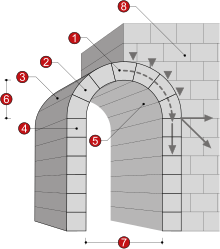Fighter (architecture)

1: Keystone
2: Wedge stone
3: Arch back
4: Fighter or abutment ; the stone is about as beginners , Gewölbefuß or more rarely, as fighters Stone called
5: arch soffit
6: random height
7: Span
8: retaining wall work
The fighter or impost is the uppermost part of the abutment of an arch or vault . Traditionally, bricks or stone slabs form the fighter, which is inserted between the wall , column or pillar and the beginning stone of the arch or vault. As a rule, the fighter jumps out a little in front of the underlying components.
As a fighter ( Latin incumba ) originally each protruding out of the wall run, load-bearing stone was called. If this protrudes particularly far and serves in particular as a support for beams or arches (which sit in front of the actual wall), it is also called a corbel or console .
A continuous fighter to support a vault is also referred to as a vault fighter , fighter class or fighter line, as well as a fighter cornice if it is decorated or profiled.
When the window of the transverse rod ( bolt ) , which the skylight is separated from the main wing, as a fighter called (see fighters window ). Together with the vertical set wood ( post ) the fighter forms the window cross .
construction
The fighter lies on a wall, a pillar or the capital of a column . It is often profiled and protrudes a little.
- In the case of a column, the cover plate on the capital is usually referred to as a fighter, which is also called an abacus in the classic antique column order . Often, however, there is still a piece of frieze and entablature on top of the abacus, so that the arch only touches above. In late antique Christian architecture, the fighter is trained as a separate block above the capital. This is usually trapezoidal in shape and thus relieves the corners of the capital below. If the transom profile and the capital consist of a single workpiece, this is the transom as a whole from a structural and structural point of view, but a formal-aesthetic distinction is made between the transom plate and the capital.
- A fighter lying in a wall can clearly protrude from the wall as a corbel. If profiled fighters are used continuously like a cornice , they form an impost (continue) or fighters cornice .
- Distinguished from the fighter is the arched foot or beginner , the first arch of the yoke above the fighter line. Occasionally, this stone is used as fighters Stone called the arc, since it rests on the fighters (which the confusion of the fighters stone with the fighters can lead itself). In Gratgewölben Speak of the Gratstein.
When building up vaults and arches, the supporting structure, the falsework , could be safely placed on the fighter until the keystone was set and the arch supported itself. This approach had several advantages: since the warrior carried the supporting structure during the construction of the vault, the scaffolding could be removed and the use of the floor below could begin. Especially when the construction dragged on for decades, as with cathedrals or fortifications, early - even provisional - use was an enormous advantage. In addition, in the case of several parallel barrel vaults such as basilicas, the vault thrust could be transferred to girders inserted horizontally into the falsework during the construction phase, until an outer rib construction caught them.
Ornamental training
The fighters are left smooth or profiled, and "then express a certain separation between the abutment and the arch". The Byzantine fighters are tall blocks. The Romanesque designs the fighter in an ornamental or figurative manner similar to the capitals. In the Gothic , the fighter almost completely disappears from the calyx bud capital. The renaissance architecture returns to the combat training of the ancient column orders.
Fighter attachment (Impost) on the acanthus capital in the Höchst Justinuskirche
Capital with impost in the Quedlinburg collegiate church
Romanesque pillar bundle with surrounding impost
(vestibule of the monastery church Denkendorf )
literature
- Entry 2nd fighter, L. Incumba, Fr. Imposte, Ital. Imposto. In: JG Krünitz: Economic Encyclopedia . tape 34 . Pauli, Berlin, p. 63 ff . ( zeno.org - 1773-1858).
- Vault . In: Lexicon of all technology
Web links
Individual evidence
- ↑ a b Hermann Alexander Müller: Illustrated archaeological dictionary of the art of Germanic antiquity: of the Middle Ages and the Renaissance, as well as iconography, costume, armory, architecture, equipment, heraldry and epigraphy related to the visual arts , p. 562, publisher O. Spamer, 1878
- ^ Uwe Miersch / Rose Engelberger: Glossary (technical terms) , In: Dresden-und-Sachsen.de; accessed in December 2019
- ^ Rudolf Redtenbacher: The architecture of modern architecture , Verlag Ernst & Korn, 1883
- ↑ fighter . In: Meyers Großes Konversations-Lexikon . 6th edition. Volume 10, Bibliographisches Institut, Leipzig / Vienna 1907, p. 524 .






